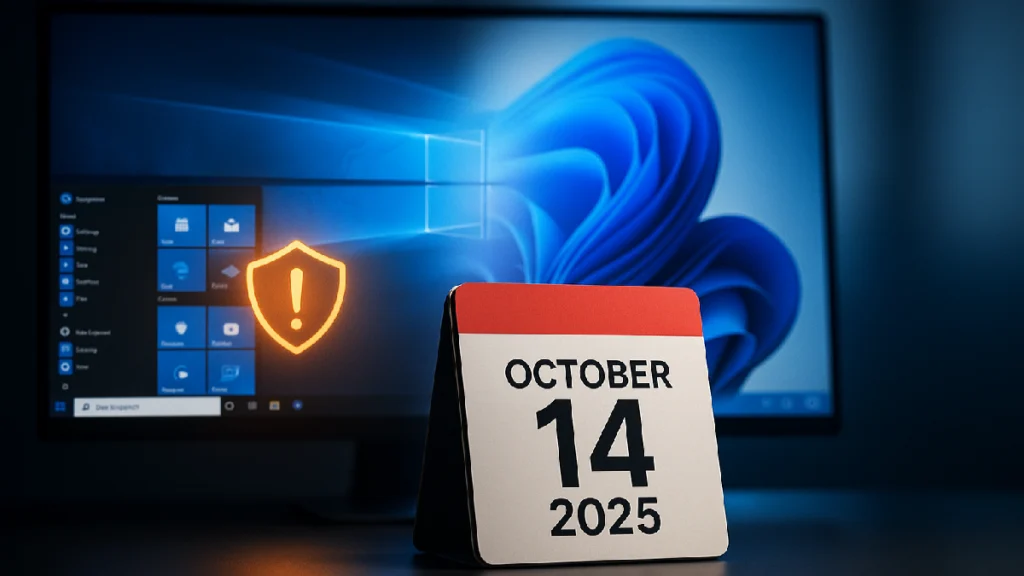Microsoft will end support for Windows 10 on October 14, 2025, which means no more security updates, technical support, or bug fixes for mainstream editions still in use on hundreds of millions of devices. The OS will continue to function, but the risk profile grows, compatibility erodes, and organizations must choose among upgrades, extended security updates, or containment strategies.

What end of support means
Windows 10 will continue to run after October 14, 2025, but it will stop receiving security patches, non-security updates, and official technical assistance for Home, Pro, and Education editions. Windows 10 version 22H2 remains the final feature release, and standard monthly servicing ends on that date for mainstream channels.
Editions and versions affected
- Home, Pro, Education stop receiving updates after the deadline.
- LTSC follows its own lifecycle; confirm edition-specific timelines.
- Version 22H2 is final; no new features are planned.
Safety valves: ESU and trade-offs
Extended Security Updates (ESU) offer post-EoS security fixes without new features, historically for organizations bridging migration gaps and now expanded with consumer enrollment paths. ESU is intentionally time-bound and should be treated as a migration bridge, not a destination.
Enrollment options and costs
- Consumer ESU enrollment via Settings, with potential free and paid paths depending on program terms.
- Business ESU available via standard channels; plan by year increments where applicable.
- No feature updates included; security-only coverage.
Limits and risks of ESU
- ESU does not restore full support parity or feature evolution.
- Coverage is temporary; plan hardware and OS transitions in parallel.
- Third-party vendors may still drop Windows 10 support regardless of ESU.
Ecosystem impact: hardware, OEMs, and supply chains
OEMs and IT suppliers are aligning guidance with Windows 11 hardware requirements (including TPM 2.0), urging compatibility checks and data migration plans. Non-compliant devices face a fork: replace, run unsupported, or remain on Windows 10 with ESU and strict risk controls.
Windows 11 readiness steps
- Run compatibility checks and inventory devices by upgradeability.
- Validate critical apps and drivers for Windows 11.
- Create phased migration plans with user communication and backups.
Paths for non-compliant devices
- Refresh or replace hardware on a prioritized schedule.
- Keep on Windows 10 with ESU plus segmentation and least privilege.
- Repurpose or retire endpoints where feasible.
Second-order effects: security and compliance
Unsupported Windows 10 endpoints become more attractive to attackers, increasing ransomware and credential theft risks. Regulated industries may face audit findings, forcing compensating controls or accelerated refreshes that can outstrip planned budgets.
Vendor and software dependencies
- Productivity suites and enterprise tools track OS support, accelerating deprecation on Windows 10.
- Peripheral and driver certification may lag or cease for Windows 10.
- Cloud management and EDR baselines increasingly assume supported OS levels.
Practical options by persona
Households and students
- Upgrade compatible PCs to Windows 11 using built-in flows; decommission or repurpose older devices.
- If staying on Windows 10, enroll in ESU and apply strong browser and app hygiene with reliable backups.
Small and midsize businesses
- Inventory fleets, prioritize critical roles for early migration, and schedule refreshes for non-compliant systems.
- Use ESU selectively for irreplaceable line-of-business systems, combining network segmentation, application allowlisting, and least privilege.
Enterprises
- Treat the cutoff as a firm risk boundary; move core fleets to Windows 11 and contain stragglers.
- Pair ESU with segmentation, EDR coverage, and privileged access controls; align vendor roadmaps to avoid a long Windows 10 tail.
Beware the do-nothing plan
Remaining on unsupported Windows 10 without ESU invites escalating risk as new vulnerabilities emerge. Compatibility will steadily degrade as browsers, drivers, and third-party apps sunset Windows 10, compounding security exposure with operational friction.
Timing and milestones to track
- October 14, 2025: end of support for mainstream Windows 10 editions.
- ESU enrollment windows: confirm availability, terms, and duration by audience.
- Ongoing: watch for changes to ESU terms, consumer enrollment requirements, and storage-linked offers.
Bottom line
This is a systemic shift, not just a version sunset, affecting hardware lifecycles, security posture, vendor support, and compliance. The lowest-risk path is timely migration to Windows 11 for compatible devices, with ESU as a time-boxed safety net for necessary holdouts.




